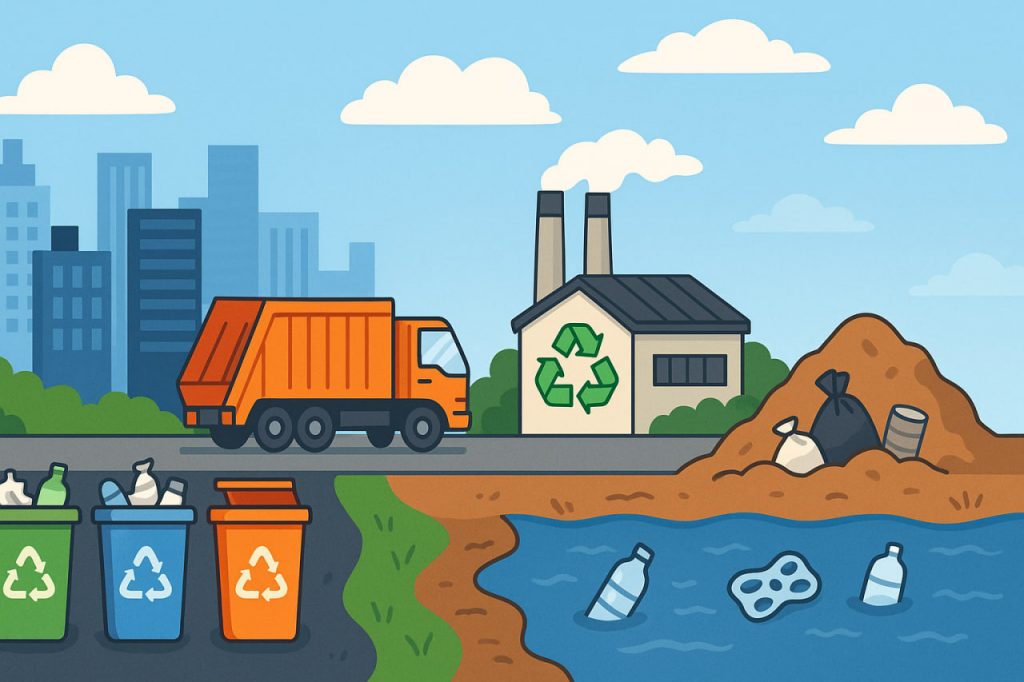Every day, billions of people around the world throw something into the trash — a bottle, a plastic wrapper, or leftover food. But once the garbage truck takes it away, few stop to think about where it goes next. The journey of waste is complex, and its outcome depends on the type of materials, the country’s recycling systems, and human habits. Understanding what happens to our trash is the first step toward solving one of the most pressing environmental challenges of our time.
The Journey of Waste
After leaving our homes, garbage typically follows one of several paths: landfilling, incineration, recycling, or composting. In many cities, trucks collect mixed waste and deliver it to sorting centers or disposal sites. There, the trash is separated — recyclable materials like metal, glass, and certain plastics are extracted, while the rest is sent for destruction or burial.
Unfortunately, in countries without efficient waste management, much of this garbage ends up in open dumps or nature, contaminating soil, rivers, and oceans. Globally, humanity produces over 2 billion tons of waste annually, and this number is growing every year.
Landfills — Hidden Mountains of Waste
The most common destination for trash is the landfill. These are massive pits where waste is compacted and buried under layers of soil. Modern landfills have systems to capture toxic liquids (leachate) and gases like methane, but many older or poorly managed sites leak pollutants into groundwater and the air.
Landfills can take centuries to break down. For example, a plastic bottle may remain intact for 400–500 years, and even organic waste, buried without oxygen, decomposes slowly, releasing harmful greenhouse gases.
Incineration — Burning the Problem Away
Another method of waste disposal is incineration, where trash is burned at extremely high temperatures. This process reduces waste volume by up to 90% and can generate electricity through waste-to-energy plants. However, it also produces toxic ash and air pollutants that must be carefully filtered.
Some modern incineration plants are highly efficient and eco-friendly, while others, especially in developing regions, contribute significantly to air pollution.
Recycling — Giving Waste a Second Life
Recycling is the most sustainable way to manage waste, as it turns old materials into new products. Glass, aluminum, paper, and many plastics can be reprocessed. For example:
- Aluminum cans can be recycled indefinitely without losing quality.
- Paper can be recycled about 5–7 times before fibers weaken.
- Plastic bottles are often turned into fabrics, containers, or new packaging.
Despite these possibilities, only about 9% of global plastic waste is currently recycled. The rest often ends up in landfills or the ocean, where it breaks down into dangerous microplastics.
Composting — The Natural Way of Recycling
Organic waste, such as food scraps, leaves, and grass, can be transformed through composting. This process uses natural microorganisms to decompose organic matter into nutrient-rich soil. Composting reduces landfill waste and creates valuable fertilizer for agriculture.
In some countries, cities now have separate bins for organic waste collection — a step toward sustainable, circular waste management.
The Problem of Ocean Pollution
A large portion of uncollected or mismanaged waste ends up in rivers, eventually flowing into the ocean. Scientists estimate that 8–10 million tons of plastic enter the seas every year, forming massive garbage patches like the Great Pacific Garbage Patch, which covers an area larger than France.
Marine animals often mistake plastic for food, leading to choking, poisoning, and death. Over time, these plastics break into microscopic particles that contaminate the food chain — including what humans eat.
The Future of Waste Management
To reduce environmental harm, countries are adopting zero-waste policies, advanced recycling technologies, and circular economy models, where products are designed to be reused or easily recycled. Innovations like biodegradable plastics, AI-powered sorting systems, and waste-to-energy technologies are helping to close the loop of waste production.
Ultimately, the best solution begins with individual responsibility — reducing consumption, reusing items, and recycling whenever possible. Every small action contributes to a cleaner, healthier planet.
Interesting Facts
- The average person produces about 700 kilograms of waste per year.
- Recycling one aluminum can saves enough energy to power a TV for three hours.
- More than 90% of marine debris is made of plastic.
- Some landfills are now being mined for valuable metals and materials — a practice called “urban mining.”
Glossary
- Landfill — a designated site where waste is buried underground.
- Leachate — toxic liquid produced when waste breaks down in landfills.
- Microplastics — tiny fragments of plastic that pollute water, soil, and food chains.
- Circular economy — an economic system focused on minimizing waste and maximizing resource reuse.
- Composting — the natural process of turning organic waste into nutrient-rich soil.


